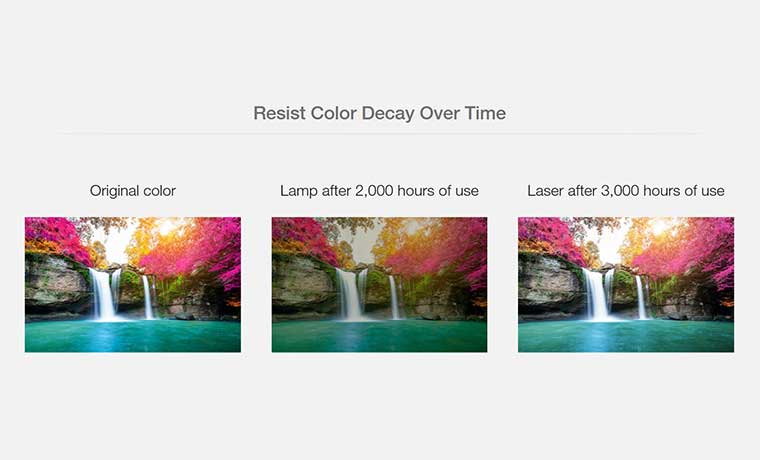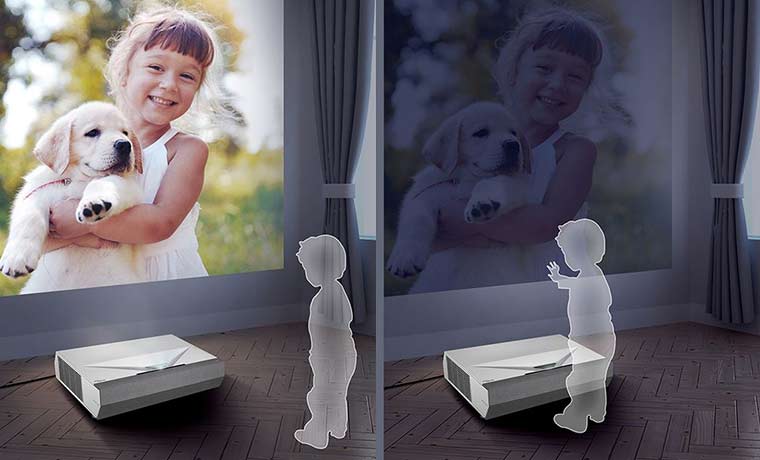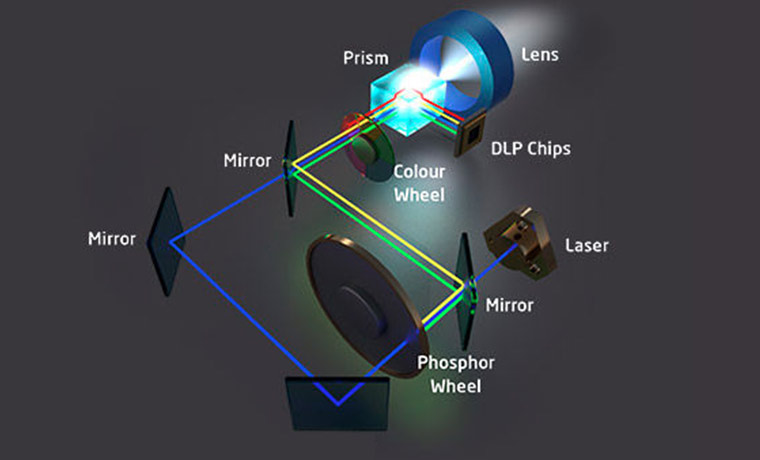BenQ W7000 Projector Screen Recommendations
The BenQ W7000 is an easy projector when it comes to finding the right projection screen. In part this is due to its brightness, and in part, due to the rather excellent black levels for a moderately priced projector.
Your room will have the most influence on your decision. Let's break it down this way: Home Theater/Caves or Livingroom/bonus room.
BenQ W7000 - projector screen - cave / home theater
Dedicated Home Theaters (or close), have common attributes such as medium to (ideally) very dark surfaces, all window lighting under full control, basically full control of other lighting, but rooms with low amounts of ambient light are in this group, be they home theaters or just darker rooms.
With the BenQ in such a room, the next question becomes how big is the screen. Strange as it may seem, the W7000 projector can actually be too bright for smaller screens (at least in 2D). We're talking well over 1000 lumens calibrated, which is about double the typical projector. Even in eco-mode, it's brighter than just about every other projector we've reviewed in the last year, when they are all calibrated.
You probably will want to have a 110" screen or larger, but you can go smaller by choosing a high contrast gray surface, with, perhaps, .8 gain. You will have to balance that decision with 3D brightness of course.
In Dynamic mode, you'll have tons of brightness, so, no worries, even with some lights on. But more importantly, your calibrated "best" mode, is almost as bright.
Unless you have placed intentional side lighting in your room (ie. sconces) or have blacked out windows that you want to open for non-movies, no need to go with anything but a white screen. Modest gain (ie. 1.3 or 1.4) is just fine and buys you a bit more screen size or image brightness. In other words, screens like the Stewart Studiotek 130 (1.3) and Carada Brilliant White (1.4) screens that are the screens I normally use.
If you do want to be able to reject some ambient light from those sides, then the better alternative are HC screens like the Stewart Firehawk, Da-lite HC Cinema Vision, and other similar screens. If you are going small screen (92" or less), you might choose a darker HC gray screen like the Grayhawk or HC-Da-Mat. The downside to those darker screens is for 3D, where brightness is relatively scarce.
Now, what happens when we go to a family room...
BenQ W7000 - projector screen - Family room
Walls are lighter, or even extremely light - off white. Ceilings and floors also brighter. Even for movie viewing, the reflected light of your image off the screen will bounce around and eventually, a noticeable amount will reflect back onto the screen. Contrast will diminish, but - an important but: Projectors with better black levels will still always look better than those without, until that point where either is badly enough washed out so as not to matter. Such is life. The good news: There are some things you can do about that.
Since the BenQ is inherently very bright, you can really match the screen, first to your room. Go with those high contrast gray screens if you need to reject side lighting. Very high gain white screens will can the same. Hmm, that could be interesting. a 2.5 gain screen 110" screen with the W7000. That should give you brightness that would make most LCDTVs jealous. While that is doable, remember; front projection still is affected more, by ambient light. That is the curse we projector owners must deal with.
As we discuss below (generically), you can get some impressive results by matching screen to room - also to the projector. That result, even in rooms that promise to be a disaster.
Below is a section we'll be repeating, to help some of you get a handle on dealing with different rooms:
First Image below taken using 128" screen, an old (2007) Sony VW60. A projector that we measured at a max of under 700 lumens. This room at that time, was football during the day, everything else, at night only. (My other room was far darker.)
The second image - same setup, the old Epson 1080UB - several generation forerunner to their current 5010, and twice as bright as the Sony.
The BenQ W7000, calibrated is roughly 3 times as bright. as the Sony, and This is the Firehawk screen. It looked far better straight back, with most of that light entering from the doors bounces toward where the camera is, in this photo.
Our assumption is, that you care about good movie performance, and also want to have good blacks, or you wouldn't be considering this projector. Rooms with a fair amount of light are often just fine for almost all HDTV and definitely sports. They won't be significantly impacted by reflected light from the original image.
This image shows the difference after darkening ceiling, and taking the walls to a dark rust color: Even with the door shades partially open, the JVC used in this picture had about the same brightness as the Sony in the first image. The moral to the story - darker walls can easily offset having fewer lumens.
I loved having that Stewart Firehawk G3 (in the images above) in my last home for handling a light surfaced room. It was 128" diagonal in a room with a cathedral celing. When I started out there, all the walls were off white, as was ceiling, and carpet was gold. Lots of windows, which I covered with pleated shades - but with no channels. The Firehawk allowed me to have a good picture even with a moderate amount of light ("can read a newspaper bright").
That HC gray screen rejects most of the side lighting. This allowed me to even have my side window shades open a few inches on sunny days, and still have a large, great football image. If your ambient is coming from straight back near the projector, like rear windows, the HC gray won't help you.
Ultimately, though, an HC gray is going to be the best choice for most folks with lighter rooms, and especially if the lights are on the sides. Consider the especially the Firehawk G3, and the various Screen Innovations Black Diamond screens (different gains, etc.) which are especially good, but also relatively pricey. Also: Elite's HC Gray, Da-lite's HC-Da-Mat, and so on. Typically we're talking screens with gains of 0.8 to 1.1 gain. The Epson's inherently pretty bright on all but the largest screens, so trading a little brightness for some ambient light rejection is a plus. (Note HC screens are a touch darker in the corners/sides.)
Don't get me wrong, you can go with a standard white surface, but in a light surfaced room, you'll appreciate the gray surface's ability to lower the overall black levels, as well as helping with side ambient light.
OK, what about 3D?
3D Screens: With active shutter glasses based 3D, almost any screen will work. I'm told there are some slight differences, but haven't heard of any real issues.
With 3D, the issue is brightness - therefore, make your decision, based on the above, for either room, consider:
You are giving up about 3/4 of the 2D brightness. So what's a nice bright 2D image, say for sports with the lights on in 2D, is a less bright than "best mode" performance.
I'm not a fan of the brighter high power screens like the Da-lite 2.5 gain, too narrow a viewing cone for my taste, but if you want really bright 3D, some of you might opt for the best 2D screen choice and get a pretty high gain screen - manual or motorized, to use only for 3D.
Hope that helps.




